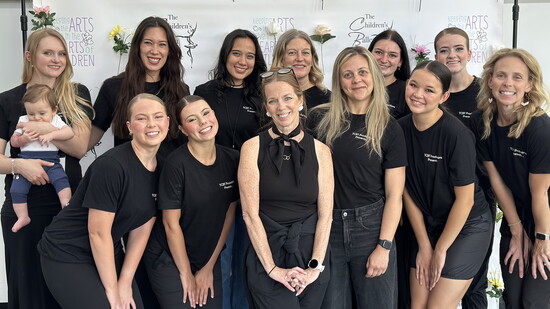In a quiet studio tucked in Spring Hill, children stretch at the barre, their focus as steady as the music echoing through the space. This is where many young dancers in Middle Tennessee take their first steps, sometimes wobbly and unsure, but always welcomed.
At The Children’s Ballet Theatre, founder Chelsea Howell has spent more than a decade shaping an environment where young people can grow through dance, not only in skill but also in self-awareness and community. Her approach is rooted in structure, patience and a belief that each child brings something unique to the studio.
“Our families have told us that they are looking for a quality classical, conservative and lovely place to raise their dancers in the very fast dance world,” Howell said. “Set with uniforms that keep them modest and respecting their bodies and driven with instructors that not only are genuine in the children’s programs but also experts in technique of ballet, modern, contemporary, progressive ballet training, pointe, pas de deux, variations and performances.”
The structure of the program reflects a long view of each student’s development. It begins with the Children’s Academy for ages 3 to 7, where students build the earliest foundations in movement, musicality and creativity. From there, students move into the Ballet Academy, designed for dancers ages 8 to 18, where training becomes more technical and goal-oriented.
“We start in the Children’s Academy. Ages 3–7 is the very first foundation of the art of dance,” Howell explained. “8–12 is a crucial growth and building time. They will create good habits in technique and flexibility. Gear up the strength and technique for that proud moment when they test to be en pointe.”
As students reach high school, they enter the Pathways program, where the focus shifts toward future opportunities. Whether dancers plan to pursue dance in college or on a professional stage, the program helps guide them toward the next step.
“Dance is like the tree trunk,” Howell said, “and then the branches and leaves are all the pathways they can take. Either collegiately or professionally, we help them get to where they want to be by 18.”
While the technical aspects of the program are rigorous, Howell said she and her staff are just as committed to the individual development of each student. “I, as well as my wonderful staff, see each dancer for their talent and what they can bring to the classroom. Each dancer is an individual of creativity and knowledge.”
Some families have been with the theatre for more than a decade and speak to the impact that kind of attention can have. One parent, C. Kelley, wrote, “We originally switched to TCBT for their training and that they would best prepare our dancers for the dance world outside of the studio as well. What we did not anticipate was the support and family that came from this decision.”
Kelley’s family has seen their children not only train at top summer intensives and perform in productions, but also work through personal challenges with the support of the TCBT community. “Our oldest daughter has had to have five surgeries and with each one, TCBT has supported her and altered her training to get her back to her full self again.”
Howell acknowledges that not every dancer is aiming for a professional path and that’s not the only measure of success. “Everyone who completes the journey at TCBT is a success story,” she said.
Part of that success, she believes, comes from exposure to more than just dance technique. The Ballet Academy includes book studies covering everything from dance and stretch anatomy to composer and costuming history. Students also learn about theater production and performance preparation.
“Our ballet academy is a training program that not only trains the dancer in the technical aspect but they also have book studies,” Howell said.
Performance plays a major role in a dancer’s experience, and Howell sees it as a way for students to develop confidence and a sense of belonging. “Each performance is a learning avenue towards a path that they are going into,” she said. “They love it so much that when it's over they are full of tears because they do not want to leave the joy they brought to the community.”
A. Robinson, whose daughter began dancing at the studio at age six, shared how ballet shaped more than just physical strength. “Yes, she has grown tremendously as a dancer, but she has also found areas of grace, discipline, self-confidence and self-expression that I had no idea she would also grow tremendously in,” Robinson said. “The Children's Ballet Theatre will always be a second home to my daughter.”
Howell emphasizes that the involvement of families and the broader community is central to the theatre’s work. “Our families are a large part of the success of the dancers,” she said. “Support, transportation, mentorship, volunteerism and questions keep us evolving and growing with each generation of dancers.”
For many families, that shared sense of purpose has helped them stay grounded in what matters most. Parent H. Westbeld described how their daughter blossomed under Howell’s direction. “We have watched her grow immensely in technique, artistry, and musicality, but additionally she has grown in confidence as a person, has gained important friendships, and has blossomed under the instruction of the wonderful teachers at TCBT.”
That blend of discipline and warmth is what keeps the doors of TCBT open year after year, not just for the next crop of dancers, but for a community of families that values creativity, consistency and care.
At The Children’s Ballet Theatre, the lessons reach far beyond choreography. They’re lessons about resilience, growth and finding one’s place on stage and beyond.
ChildrensBalletTheatre.com
“Dance is like the tree trunk,” Howell said, “and then the branches and leaves are all the pathways they can take. Either collegiately or professionally, we help them get to where they want to be by 18.”
